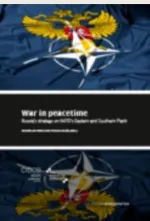Presentation. War in peace

NATO and the EU are facing an increasingly uncertain and complex situation with overlapping crises on their eastern and southern borders. The increasingly aggressive military posture of the Kremlin represents one of the main challenges for NATO and the EU. Russia is showing willingness to compete strategically and to confront the two organisations directly, right now, both in their common neighbourhood and on the ideological and political level in their respective domestic contexts. NATO and the EU, meanwhile, are still only in the process of trying to build a sound strategy to deal with this multidimensional political warfare.
When it comes to the Eastern and Southern flanks, NATO has, to date, favoured an approach which analyses the threats separately. Those who focus on the Mediterranean know little of Russia, while Russia and Eastern European experts know even less of the southern and eastern rim Mediterranean countries. Issues and interests are, however, increasingly cross-linked, if not intertwined. Yet NATO members have different perceptions, interests and therefore agendas which are linked to history and economics, possession or not of effective armies and energy dependence, and these differences risk seriously fragmenting NATO’s analysis.
Consequently, perceptions of Russian behaviour differ significantly. With regard to NATO’s Eastern flank, there is broad agreement that Russia is the major destabilising factor and a clear threat to some member states of NATO. But where Russian policy in the eastern and southern Mediterranean are concerned, views differ significantly. Some southern European countries, while fully committed to their obligations on NATO’s Eastern flank, seem less worried than their northern European peers about Russia’s renewed projection of power in Syria after an absence of two decades, let alone in Libya. Countries on the southern rim, notably Algeria - which is an important military power and energy supplier to Europe- are essentially on the same wavelength as Russia with regard to Syria. They also share Russian criticism of the manner in which events unfolded in Libya in 2011. In particular, Algeria was upset that its warning to leading Western capitals about the serious fallout that would ensue from the demise of the Libyan leader, both in North Africa and the Sahel, were ignored.
The context of both flanks could not be more different. In the East, the lines of confrontation are clear. Russian behaviour has restored deterrence and collective defence as the Alliance’s core purposes. Defining a clear strategy to counter hybrid warfare has begun, though it remains very much a work in progress. In the Mediterranean, however, NATO has yet to define an overarching structure to deal with the complex challenges the region presents, notably those related to governance issues and the strengthening of existing states.
Energy presents a further challenge: Russian gas supply to the EU offers the Kremlin leverage, which will only be increased if Nord Stream 2 is built. Meanwhile the four underwater gas pipelines which link Algeria (3) and Libya (1) to Europe are running more than half empty. NATO and the EU should develop their strategic dialogue with Algeria and Libya, both of which have huge reserves of oil, gas and shale. The EU meanwhile must continue to develop the gas connection between its members, notably that between Spain and France. Such policies would contribute to enhancing the EU’s security of energy supply, rendering Europe less vulnerable to Russian pressure.
Eight papers by respected authors attempt to shed more light on these seriously complex issues and to suggest ways forward. The authors brought together here come from backgrounds which seldom allow them to exchange views. We think more work is needed on how the challenges from East and South can be assessed jointly and seen as one, allowing the creation of a more coherent overall strategy for NATO. Chris Donnelly’s Epilogue offers the long view of someone well versed in the art of strategic planning.